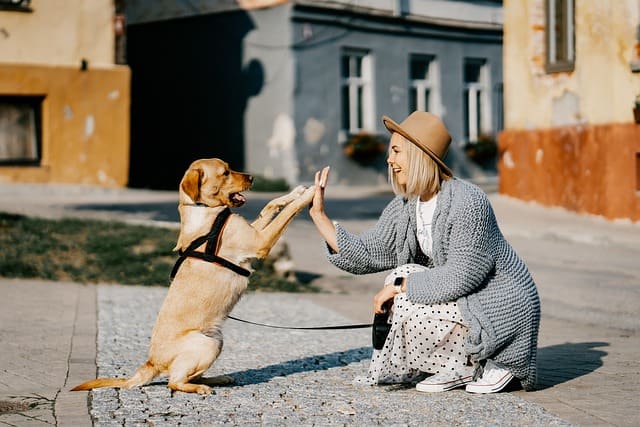Have you heard about dog training hand signals …
Yes, You are right. Hand Signals are just more than gestures. They can help you train your dog even better.
Dogs are incredibly perceptive animals. They are masters at reading body language and visual cues. Integrating hand signals into your training sessions can help your dog understand what you want more clearly, even in noisy or crowded environments where verbal commands may get lost.
Hand signals provide a visual cue that is easy for dogs to interpret, making training more efficient and effective. Dog training hand signals are invaluable because they provide clarity and precision.
This guide will explore the basics of dog training hand signals, how to use them effectively, and their numerous benefits.
So, let’s start…
Dog Training Hand Signals
Dog training hand signals are gestures or movements made with the hands to communicate a command or message to a dog.
They serve as non-verbal communication, allowing for clear, concise instructions that can be particularly useful in situations where verbal commands may not be practical, such as in noisy environments or when the dog is at a distance.
The History of Dog Training Hand Signals
The use of hand signals in dog training has a rich history, dating back centuries. It is believed that the military and hunting communities were among the first to adopt hand signals to communicate with dogs, as they provided a silent way to convey commands during operations or hunts.
This long-standing tradition of using hand signals has been refined and expanded by dog trainers and behaviorists, making it a trusted and effective training method.
The Basics of Dog Training Hand Signals
Introducing hand signals to your dog is straightforward. Start by pairing a specific gesture with a corresponding command, and repeat this association until your dog learns to understand it. Consistency is vital in this process, so always use the same gesture for a specific command to avoid confusion. Your dog will soon learn to respond to your hand signals with patience and repetition.
The Benefits of Dog Training Hand Signals
Using hand signals in dog training offers many benefits for the dog and the owner. Here are some of the key advantages:
1. Clear Communication

Hand signals provide a clear, visual means of communication that can help eliminate confusion. Dogs are incredibly perceptive to visual cues, and using hand signals alongside verbal commands can reinforce understanding and compliance.
2. Distance and Noise
Hand signals can be invaluable when verbal commands are complex, or the dog is too far away to hear. They ensure the dog receives clear and consistent commands, whether at a distance or in a noisy environment.
3. Universal Understanding
Dogs naturally rely on body language to communicate, making hand signals universal and easily understood regardless of language barriers. This makes hand signals an excellent option for dog owners who speak different languages or for dogs trained by multiple handlers.
4. Bonding and Trust

Implementing hand signals in training fosters a deeper understanding and trust between the dog and its owner. Learning and responding to hand signals strengthens the bond, leading to a more harmonious relationship.
5. Mental Stimulation
Learning to respond to hand signals provides mental stimulation for dogs, making their minds active and engaged. This mental stimulation can be beneficial for intelligent breeds or high-energy dogs.
6. Versatility:
Hand signals can be used in various environments and situations, making them versatile tools for practical training.
7. Assistance for Hearing-Impaired Dogs:
Hand signals are essential for dogs with hearing impairments. They allow these dogs to understand commands as effectively as their hearing counterparts.
How to Introduce Dog Training Hand Signals
1. Start with Basic Commands
Begin by introducing hand signals for basic commands that the dog already knows. This will make the association between the command and the hand signal easier for the dog to understand. Some basic commands to start with include:
Sit:
With an open palm facing upward, raise your hand from your side to above your head.
Stay:
Extend your arm and palm out in a stop signal.
Come:
Hold your arm outstretched and motion your hand towards your chest.
2. Use Consistent Gestures
Consistency is critical when introducing hand signals. Use the same gesture to prevent confusion each time you give a command. Dogs learn through repetition, so be patient and give them time to understand the association between the hand signal and the command.
3. Pair Hand Signals with Verbal Commands
Initially, pair the hand signal with the verbal command. For example, say “sit” while giving the hand signal for sit. Over time, you can gradually phase out the verbal command, relying solely on the hand signal.
4. Reinforce and Reward
Positive reinforcement is crucial in dog training. When your dog responds accordingly to a hand signal, immediately reward them with praise, treats, or affection. This positive feedback reinforces the behavior and encourages the dog to continue responding to the hand signal.
5. Practice Regularly
Practice the hand signals regularly in short training sessions. Consistent practice will help solidify the association between the hand signal and the command in your dog’s mind.
Advanced Dog Training Hand Signals
Once your dog knows the basic commands, you can introduce more advanced hand signals to expand their training. Some examples of advanced hand signals include:
Lie Down:
With an open palm facing downward, move your hand from a raised position to the ground.
Heel:
Extend your arm straight down with your hand in a fist.
Fetch:
Point towards the object you want the dog to retrieve.
Wait:
Raise your hand, palm facing the dog, and make a stopping motion.
Good Dog/Well Done:
Raise your thumb and first two fingers, forming an “okay” sign, and bring it to your face, touching your chin or lips.
No:
Extend your arm forward, palm facing the dog, and make a firm, downward motion.
Quiet:
Point your index finger to your lips.
Go to Your Place/Bed:
Point to the designated spot where you want your dog to go.
Troubleshooting Common Issues
1. Lack of Response
Return to basics if your dog is not responding to a hand signal. Revisit the command with which the dog is struggling and practice it more frequently.
2. Confusion
If your dog seems confused, ensure you use hearing, distinct hand signals. Avoid making similar gestures for different commands.
3. Distractions
If your dog is having difficulty focusing in a distracting environment, start with short training sessions in a quiet space, gradually increasing the level of distraction as they become more proficient.
Conclusion:
Dog training hand signals are a valuable tool that can significantly enhance the training experience for bogs and their owners.
By providing clear visual cues, hand signals improve communication, strengthen the human-canine bond, and aid in the training process.
Whether teaching basic commands or more advanced behaviors, integrating hand signals into your training regimen can lead to a more obedient, well-behaved dog and a deeper, more fulfilling relationship.
With the right approach, you can effectively teach your dog to understand and respond to hand signals, opening up a new world of communication and understanding.
Remember, success is associated with patience and consistency. With time and desired practice, your dog will become proficient in understanding and responding to hand signals, enriching your relationship and creating a harmonious and fulfilling partnership.

